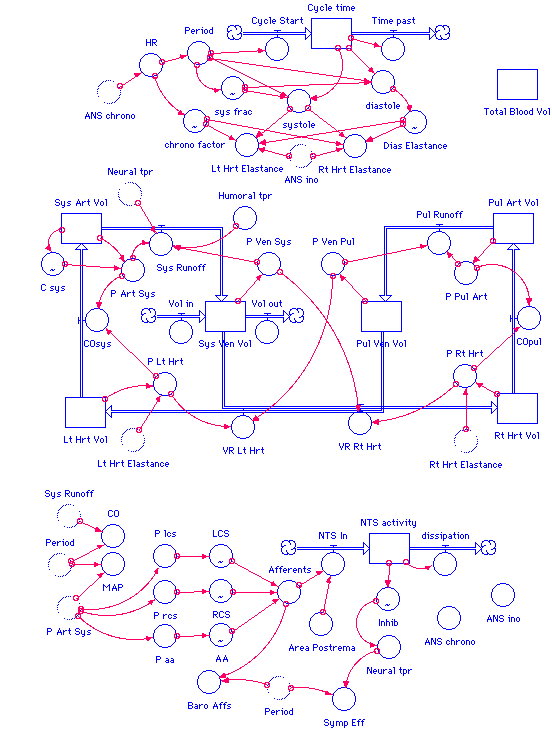

A glossary of abbreviations and a list of equations are available for this model.
The STELLA® pulse into the cycle time reservoir is a means of getting a systolic stop-watch that starts at zero at the beginning of each cardiac cycle. The time point in systole in turn sets the ventricular elastance, which in turn determines the ventricular volume. The chronofactor modifies the elastance so that ventricular pressure rises faster as heart rate increases.
ANSchrono and ANSino stand for autonomic nervous system chronotropic and autonomic nervous system inotropic (see glossary of abbreviations), the standard terms used to describe the ANS effect on heart rate and contractibility, respectively. ANS control of heart rate is mediated by the vagus and sympathetic nerves. ANS control of cardiac contractility is under sympathetic neural control. Heart rate and contractilility are also controlled by humoral factors(e.g epinephrine, vasopressine, etc.). The only humoral component included in the model is humoral tpr.
As mentioned before, the timing of the model is complicated. The model starts by calculating the duration of the cardiac cycle(i.e. Period=60/HR). The model breaks the cardiac cycle into two phases, systolic and diastolic. The simplest approach would have been to fix the duration of systole and diastole as constant fractions of the cardiac period (e.g.) systole occurs during the first third of the cardiac cycle). However, systole is not a fixed fraction of the cardiac cycle. Once the A-V node fires, the left ventricle depolarizes at a relatively fixed rate. Consequently, at low heart rates (long periods) the systolic fraction ("sys frac") occupies less than a third of the cardiac cycle. The literature indicates that the relationship between systolic duration and cardiac period is non-linear and flattens out at still higher heart rates. Diastole is the time remaining in the cardiac cycle.
Furthermore, C sys is the arterial compliance. CO sys is the instantaneous cardiac output from the left ventricle. It is not used for anything in particular, but STELLA® requires a flow regulator between reservoirs.
Model specifics include a simulation time of 50 seconds, using a step time of 0.01 seconds. Using these specifics, each variable is calculated 5,000 times. The model uses Euler's method as an integrator.
This model has been converted to Fortran for a high-performance workstation (Silicon Graphics) to provide accessibility through this Web page. The simulation uses the addition tools of Perl and gnuplot to process input information, run the Fortran code, and generate real-time graphs using gnuplot and other image-conversion tools. You can run the model using the form input below.